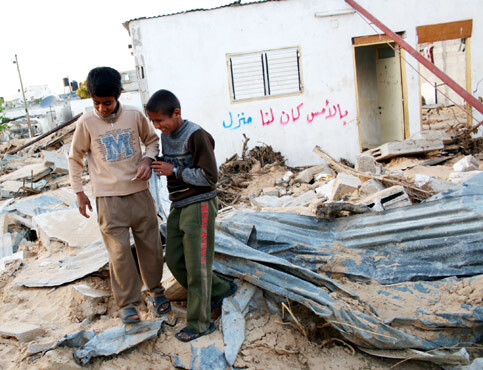The Electronic Intifada 16 April 2007

A street wrecked by a flood of sewage and left under tons of sand. Graffiti on he house bears the phrase ‘Yesterday we had a house.’ (Tom Spender/IRIN)
UMM NASSER, 16 April 2007 (IRIN) - Hundreds of Bedouin families living in tents after their north Gaza village was flooded with sewage are in urgent need of medicine and blankets, the UN and local doctors have warned.
Three hundred families are living in tents pitched on high ground near Umm Nasser, the village that was flooded after a filtration basin broke, sending thousands of cubic metres of sewage into the village on 27 March. Five residents were killed in the flood and 18 more were injured.
“We do not have enough medication or blankets for these people,” said Dr Abdurrahman Shahwan of the nearby Balsam Military Hospital.
But while the families are no longer at risk of being drowned in what they describe as a ‘tsunami’ of raw sewage, they still face other health problems as they wait for new homes.
The Bedouins’ proximity to the waste water basins mean they are at increased risk of getting skin infections from insects transferring toxins from the sewage to the families, Shahwan said, while the fumes from the sewage cause high rates of respiratory conditions such as asthma.
“Some people here have skin infections that cover their whole bodies, while breathing in the gas from the sewage is unhealthy. We need more antibiotics, anti-allergenic drugs and skin creams,” he said.
The absence of basic sanitation facilities and the prevalence of sewage-infiltrated households will also encourage diseases, the UN has warned.
A few temporary toilets have been set up among the tents for the evacuees to use — but if they want to wash themselves they need to go back to their wrecked and contaminated houses.
Shahwan added that despite the warmer weather, the families do not have enough blankets. Some families have taken to lighting fires inside their tents.
The homes and streets of Umm Nasser are now submerged under more than a metre of sand carried by the flood, leaving just the tops of doorways visible above the sand.
Residents have returned to graffiti their former homes referring to Umm Nasser’s ‘disaster’ and expressing their refusal to resettle the village. “We will not return to our deaths,” reads one slogan.
They say they have agreed to be resettled, perhaps to a site in the former Israeli coastal settlement of Gush Katif in the southern Gaza Strip — but they also say they want to be allowed to build their own homes.
“Of course we do not want to go back to Umm Nassser. We agree to move. But we want to build houses as we wish,” said 32-year-old Youssef Milat, who is now living in a tent with his wife and four children.
However, Milat knows that a new home for his family is still some way off.
“This is just the beginning. We have no idea how long it is going to take,” he said.
This item comes to you via IRIN, a UN humanitarian news and information service, but may not necessarily reflect the views of the United Nations or its agencies. All IRIN material may be reposted or reprinted free-of-charge; refer to the copyright page for conditions of use. IRIN is a project of the UN Office for the Coordination of Humanitarian Affairs.
Related Links
